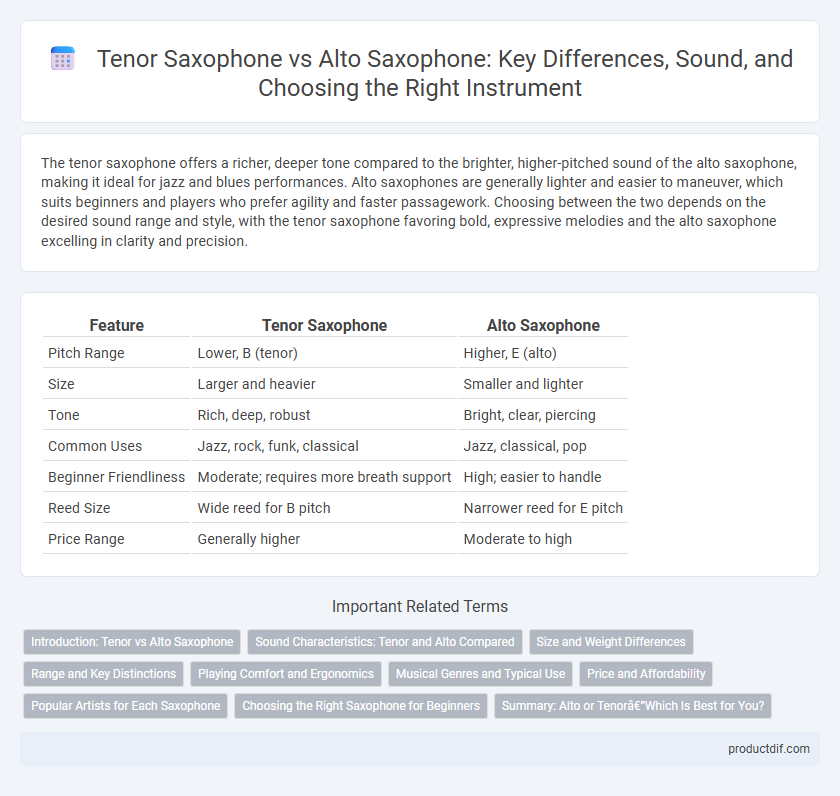The tenor saxophone offers a richer, deeper tone compared to the brighter, higher-pitched sound of the alto saxophone, making it ideal for jazz and blues performances. Alto saxophones are generally lighter and easier to maneuver, which suits beginners and players who prefer agility and faster passagework. Choosing between the two depends on the desired sound range and style, with the tenor saxophone favoring bold, expressive melodies and the alto saxophone excelling in clarity and precision.
Table of Comparison
| Feature | Tenor Saxophone | Alto Saxophone |
|---|---|---|
| Pitch Range | Lower, B (tenor) | Higher, E (alto) |
| Size | Larger and heavier | Smaller and lighter |
| Tone | Rich, deep, robust | Bright, clear, piercing |
| Common Uses | Jazz, rock, funk, classical | Jazz, classical, pop |
| Beginner Friendliness | Moderate; requires more breath support | High; easier to handle |
| Reed Size | Wide reed for B pitch | Narrower reed for E pitch |
| Price Range | Generally higher | Moderate to high |
Introduction: Tenor vs Alto Saxophone
The tenor saxophone produces a deeper, richer sound with a lower pitch range compared to the alto saxophone, which offers a brighter and higher tone. Due to its larger size and curved neck, the tenor saxophone is heavier and requires more breath control, making it popular in jazz and blues genres. The alto saxophone, being smaller and lighter, is favored for its agility and is commonly used in classical, marching bands, and beginner music education.
Sound Characteristics: Tenor and Alto Compared
The tenor saxophone produces a deeper, richer sound with a warmer and more robust tone compared to the alto saxophone's brighter, sharper, and more piercing sound. The alto saxophone sits higher in pitch, offering greater agility and clarity, making it ideal for melodies and fast passages. In contrast, the tenor's sound is fuller and more resonant, favored for its versatility in jazz, rock, and blues genres.
Size and Weight Differences
The tenor saxophone is larger and heavier than the alto saxophone, measuring about 31 inches in length and weighing around 6 pounds, whereas the alto saxophone typically measures 25 inches and weighs approximately 4 pounds. The increased size of the tenor saxophone contributes to its deeper, richer tone compared to the brighter sound of the smaller alto saxophone. Weight differences impact playability, making the alto saxophone more suitable for beginners and those seeking a lighter, more portable instrument.
Range and Key Distinctions
The tenor saxophone, pitched in B, has a lower range extending from A2 to E5, providing a deeper, richer tone compared to the alto saxophone, which is pitched in E and spans from D3 to A5. The alto saxophone's higher register allows for brighter, more piercing sounds ideal for lead melodies, while the tenor's key and range offer versatility in jazz and classical compositions. Understanding these distinctions helps musicians select the instrument best suited for their stylistic and tonal preferences.
Playing Comfort and Ergonomics
The tenor saxophone offers a larger mouthpiece and body, requiring more lung capacity and finger strength compared to the alto saxophone, which is smaller and lighter, enhancing ease of play for beginners and long sessions. Alto saxophones feature a more compact key layout and lighter weight that reduce hand and arm fatigue, making them ideal for players prioritizing comfort and extended practice. Ergonomically, the alto's design supports better posture and less strain, while the tenor's size demands greater physical endurance and precise hand positioning.
Musical Genres and Typical Use
The tenor saxophone is prominently used in jazz, blues, and rock due to its deeper, richer tone that complements dynamic solo performances and ensemble settings. The alto saxophone, favored in classical music, jazz, and funk, offers a brighter, higher-pitched sound suitable for melodic lines and fast-paced improvisation. Both saxophones are essential in jazz combos, but the tenor's versatility makes it a staple in various musical genres, while the alto often leads in educational and marching band contexts.
Price and Affordability
The tenor saxophone generally costs more than the alto saxophone, with beginner models ranging from $600 to $1,200 compared to the alto's typical range of $400 to $900. Maintenance and reed expenses are slightly higher for tenor saxophones due to their larger size, impacting long-term affordability. Budget-conscious buyers often prefer alto saxophones for their lower initial price and reduced upkeep costs.
Popular Artists for Each Saxophone
Prominent tenor saxophone players include John Coltrane and Sonny Rollins, known for their influential contributions to jazz with deep, rich tones. Alto saxophone is famously associated with Charlie Parker and Cannonball Adderley, whose agile phrasing and bright sound shaped bebop and hard bop styles. These artists highlight the distinct sonic qualities and technical versatility unique to each saxophone type.
Choosing the Right Saxophone for Beginners
Choosing the right saxophone for beginners often depends on size, sound, and playability; the alto saxophone is smaller and lighter, making it easier for younger players to handle and produce a clear tone. In contrast, the tenor saxophone, larger with a deeper sound, may require more lung capacity and finger strength, which suits older or more physically developed beginners. For beginners seeking versatility and ease of learning, the alto saxophone typically offers the most accessible starting point.
Summary: Alto or Tenor—Which Is Best for You?
The Alto Saxophone offers a higher pitch and is lighter, making it ideal for beginners and those seeking agility in jazz or classical music. The Tenor Saxophone provides a deeper, richer tone favored in genres like rock, blues, and big band, suiting players who want powerful, expressive sounds. Choosing between alto and tenor depends on your musical style, desired sound range, and physical comfort in handling the instrument.
Tenor Saxophone vs Alto Saxophone Infographic

 productdif.com
productdif.com